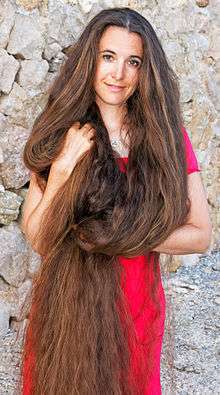Human hair growth
The growth of human hair occurs everywhere on the body except for the areolas, soles of the feet, the lips, palms of the hands, some external genital areas, the navel, scar tissue, and, apart from eyelashes, the eyelids. Like skin, hair is a stratified squamous keratinized epithelium made of multi-layered flat cells whose rope-like filaments provide structure and strength to the hair shaft.
Hair follows a specific growth cycle with three distinct and concurrent phases: anagen, catagen, and telogen phases. Each phase has specific characteristics that determine the length of the hair. All three phases occur simultaneously; one strand of hair may be in the anagen phase, while another is in the telogen phase.
The body has different types of hair, including vellus hair and androgenic hair, each with its own type of cellular construction. The different construction gives the hair unique characteristics, serving specific purposes, mainly warmth and protection. Most humans develop the longest thickest hair on their scalps and (mostly observed in males) faces. This hair will usually grow to several feet before terminating, but many humans develop much longer hair.
Growth cycle


The three stages of hair growth are the anagen, catagen, and telogen phases. Each strand of hair on the human body is at its own stage of development. Once the cycle is complete, it restarts and a new strand of hair begins to form. The rate or speed of hair growth is about 1.25 centimetres or 0.5 inches per month, or about 15 centimetres or 6 inches per year.
Anagen phase
The anagen phase is known as the growth phase. It begins in the papilla and can last from two to six years.[1][2] The span at which the hair remains in this stage of growth is determined by genetics. The longer the hair stays in the anagen phase, the longer it will grow. During this phase, the cells in the papilla divide to produce new hair fibers, and the follicle buries itself into the dermal layer of the skin to nourish the strand. About 85% of the hairs on one's head are in the anagen phase at any given time
Catagen phase
Signals sent out by the body (that only selectively affect 1 percent of all hair of one's body at any given time) determine when the anagen phase ends and the catagen phase begins. The first sign of catagen is the cessation of melanin production in the hair bulb and apoptosis of follicular melanocytes.[3] The catagen phase, also known as the transitional phase, allows the follicle to, in a sense, renew itself. During this time, which lasts about two weeks, the hair follicle shrinks due to disintegration and the papilla detaches and "rests," cutting the hair strand off from its nourishing blood supply. Ultimately, the follicle is 1/6 its original length, causing the hair shaft to be pushed upward. While hair is not growing during this phase, the length of the terminal fibers increase when the follicle pushes them upward.
Telogen phase
During the telogen or resting phase the follicle remains dormant anywhere from 1–4 months. Ten to fifteen percent of the hairs on one's head are in this phase of growth at any given time. In this phase the epidermal cells lining the follicle channel continue to grow as normal and may accumulate around the base of the hair, temporarily anchoring it in place and preserving the hair for its natural purpose without taxing the body's resources needed during the growth phase.
At some point, the follicle will begin to grow again, softening the anchor point of the shaft initially. The hair base will break free from the root and the hair will be shed. Within two weeks the new hair shaft will begin to emerge once the telogen phase is complete. The process results in normal hair loss known as shedding.
Growth inhibitors and disorders
Chemotherapy
Most chemotherapy drugs work by attacking fast-replicating cells. Rapid cell replication is one of the hallmarks of cancer; however, hair follicle cells also grow and divide quickly. Consequently, the chemotherapy drugs usually inhibit hair growth. The dose and type of medicine determine the severity of hair loss, but once the chemotherapy has ended, new hair growth may begin after three to 10 months.
Alopecia-related syndromes
Alopecia is a hair loss disease that can occur in anyone at any stage of life. Specifically Alopecia areata is an autoimmune disease that causes hair to spontaneously fall out. It is mainly characterized by bald patches on the scalp or other parts of the body, and can ultimately cause baldness across the entire body. This disease interferes with the hair growth cycle by causing a follicle to prematurely leave the anagen, or active growth, phase and enter the resting, or telogen phase. The hair growth in the affected follicles is lessened or stopped completely.
Traction alopecia is caused by adding too much strain on the hair on one's head. Tight ponytails and other styles that require added tension to the hair are often what cause this disease. It can also occur on the face in areas where the hair is often styled. Plucking or waxing one's eyebrows frequently, for example, can yield suppressed hair growth in the area.
On the scalp, the hair is usually known to be lost around the hair line, leaving the densest amount of hair at the crown. Small vellus hair will often replace the hair that is lost. In most people, scalp hair growth will halt due to follicle devitalization after reaching a length of generally two or three feet. Exceptions to this rule can be observed in individuals with hair development abnormalities, which may cause an unusual length of hair growth.
Radiation therapy to the head
Human hair follicles are very sensitive to the effects of radiation therapy administered to the head, most commonly used to treat cancerous growths within the brain. Hair shedding may start as soon as two weeks after the first dose of radiation and will continue for a couple of weeks. Hair follicles typically enter the resting telogen phase and regrowth should commence 2.5 to 3 months after the hair begins to shed. Regrowth may be sparser after treatment.
UV-B
UV levels of either 20 or 50 mJ cm−2 in the UV-B range have been shown to inhibit hair growth, reduce hair melanin and damage hair follicles.[4]
Hair-growth stimulants
See also
References
- ↑ A. Y. Elzouki; H. A. Harfi; H. Nazer; William Oh; F. B. Stapleton; R. J. Whitley (eds.). Textbook of clinical pediatrics (2. ed.). Berlin: Springer. p. 1489. ISBN 9783642022012.
- ↑ Braun-Falco, Otto (2000). Dermatology (2., completely rev. ed.). Berlin: Springer. p. 1101. ISBN 9783540594529.
- ↑ Rita, Araújo; Margarida, Fernandes; Artur, Cavaco-Paulo; Andreia, Gomes (2010). "Biology of Human Hair: Know Your Hair to Control It" (PDF). Adv Biochem Engin/Biotechnol.
- ↑ "Profiling the Response of Human Hair Follicles to Ultraviolet Radiation". nature.com. Retrieved 2015-06-30.